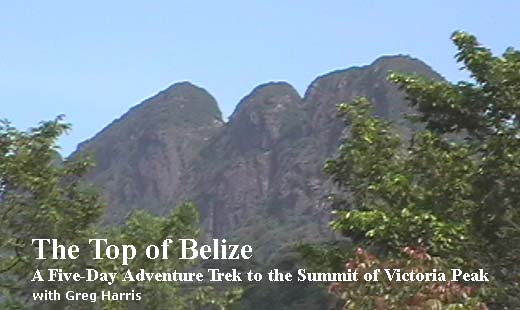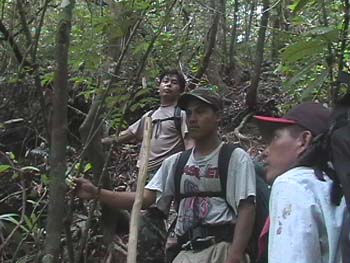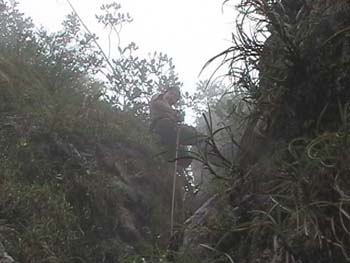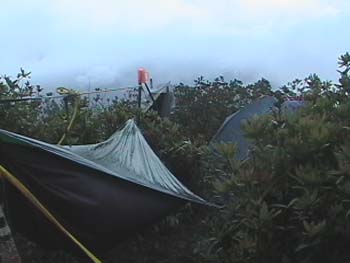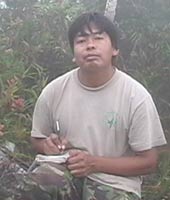In the winter of 1993, I hardly even knew that the country of Belize exisited. That was until I read "Jaguar", Alan Robinowitzs' dramatic account of his attempt to create the world's first Jaguar Reserve. One passage was exceptionally intriguing to me. It was his description of Victoria Peak, then thought to be the tallest mountain in Belize. Alan wrote, "It was not until 1984, while I was in the basin, that a group of fifteen Belize Defense Forse soldiers made what was to my knowledge the first successful attempt from the south. It took them two weeks, and only one man, a Maya Indian, made it to the top of Victoria Peak." I wondered how many people had been successful in climbing to the top of that mysterious and remote mountain in the 9 years since Alan wrote that passage. I vowed that one day, I would follow in the foot prints of that one Maya man, and climb to the top of Victoria Peak. Ten years later, in July of 2003, I had my chance. Victoria
Peak (3675 feet) is located on the remote northern boundary of
the 150 sq. mile Cockscomb Basin Wildlife Sanctuary and Jaguar
Preserve. Anyone who has been off the coast of Belize on a clear
day has seen it looming in the distance. Big, tall and impressive.
It is often shrouded in clouds and until recently thought to be
the highest mountain in Belize. It is a total of 28 km to the
summit from the Cockscomb headquarters. So the round trip is approx.
35 miles. It was indeed a difficult hike, often described as the
"hardest hike in Belize." |
||||||
|
||||||
We started climbing Victoria Peak up a dry creek bed that eventually
turns into solid stone. Most of the way to the top was 60 degree
or more incline up wet stone. Good foot holds but very slippery
and potentially very dangerous. Because of the remote location
and treacherous terrain, a fall here could be a real disaster..
At this point it is a good idea to have some basic climbing gear
to help over the 'rough spots'. Marcos Cucul, my guide and friend
is an accomplished climber. I am not. When the climbing became
too difficult or too dangerous in my opinion, he would fix some
ropes. The 'trail' continued straight up then eventually veered
left and leveled out onto a very narrow path (2 feet) with a 700-800+
foot fall over the other side. Not good for those prone to vertigo.
After several hundred feet the trail terminated next to a vertical
rock face that had to be scaled. It was only 50 or 60 feet high
and not a problem with good climbing equipment . From the top
of the rock face we scrambled over another series of small steep
inclines and rock faces. Here the forest changes dramatically.
A very wet tropical forest environment dripping with moisture
and moss. Then, tired and exhilarated, we finally reached the
summit! The total time it took us from the camp at km 19 to the
top was approx. 7 1/2 hours of continuous hard hiking and climbing.
|
||||||
Most people or groups give up before reaching this point. I believe it is because alot of guides expect people to climb to the top, stay 15 minutes, then climb back down and make that difficult hike all the back to km 19. That's a 12-14 hour day and most expeditions find that there is not enough daylight to complete the hike before sunset, so they turn back. We did not have that concern because we camped on the summit. Probably the first expedition to do so. The primary advantage of making the summit in one day and returning to camp km 19 is that you don't have to carry much gear. Just water and some food. We, on the other hand had to carry all our camping gear up to the summit. But it was well worth the effort. It cleared when we reached the top and the view was inspirational. The air was cool and crisp. A thick carpet of unbroken forest and mountain ranges stretched as far as the eye could see. But quickly it changed and the clouds moved in. The wind picked up along with a strong drizzle and the temperature dropped. We pitched our hammocks among the stunted growth of foliage and spent a somewhat sleepless night listening to the winds roar with a thick mist swirling around us. The next day, day four, we were completely fogged in. No view, just a strong wind from the East. We started the climb back down Victoria Peak early in the morning.. I found the climb down much more intimidating than the ascent. We used the ropes to repel over the most dangerous areas and hiked back to km 19 in about 6 1/2 hours. There is a wonderful jungle stream close by and a small waterfall that created the most exhilarating shower. A great place to wash away the days hike and get refreshed. That evening our group sat around the camp fire sharing stories. Valentino told fascinating stories about the diverse wildlife he has encountered in the jungles of Belize. Marcos spoke about his various trekking and climbing adventures and his love of his Mayan ancestry. I mainly just listened, content to be in their company and remembering that one Maya man who first made the summit less than twenty years earlier. Marcos told me that less than 175 adventurers have climbed to the top of Victoria Peak since then. And unless you are very well prepared I can see why. We were well prepared. |
|||
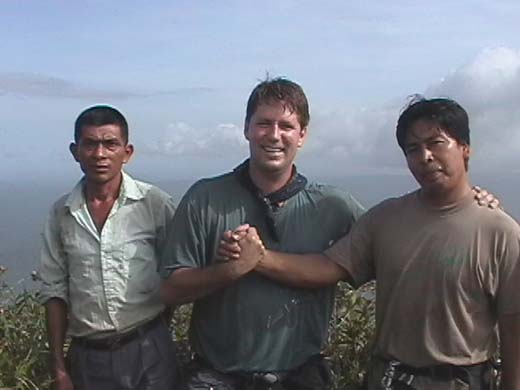 |
|||
Valentino,
Greg and Marcos on the top of Victoria Peak. |
|||
|
|||
The
next morning, day five. We hiked from camp km 19 all the way back
to the Cockscomb headquarters. Approx. 12 miles of steady hiking..
But we did stop often to observe the bird life. We saw a 'Bush
Dog' dash across the trail. We smelled the strong odor of a peccary
herd. We hiked in the pouring rain. We listened to Toucans sing
in the trees and we saw a snake whip past. We slipped and fell
on the wet trail. We were tired and wet and very happy campers
when we arrived at Cockscomb headquarters as the sun slipped beneath
the jungle canopy.
All photos provided by Greg Harris. All rights reserved. |

